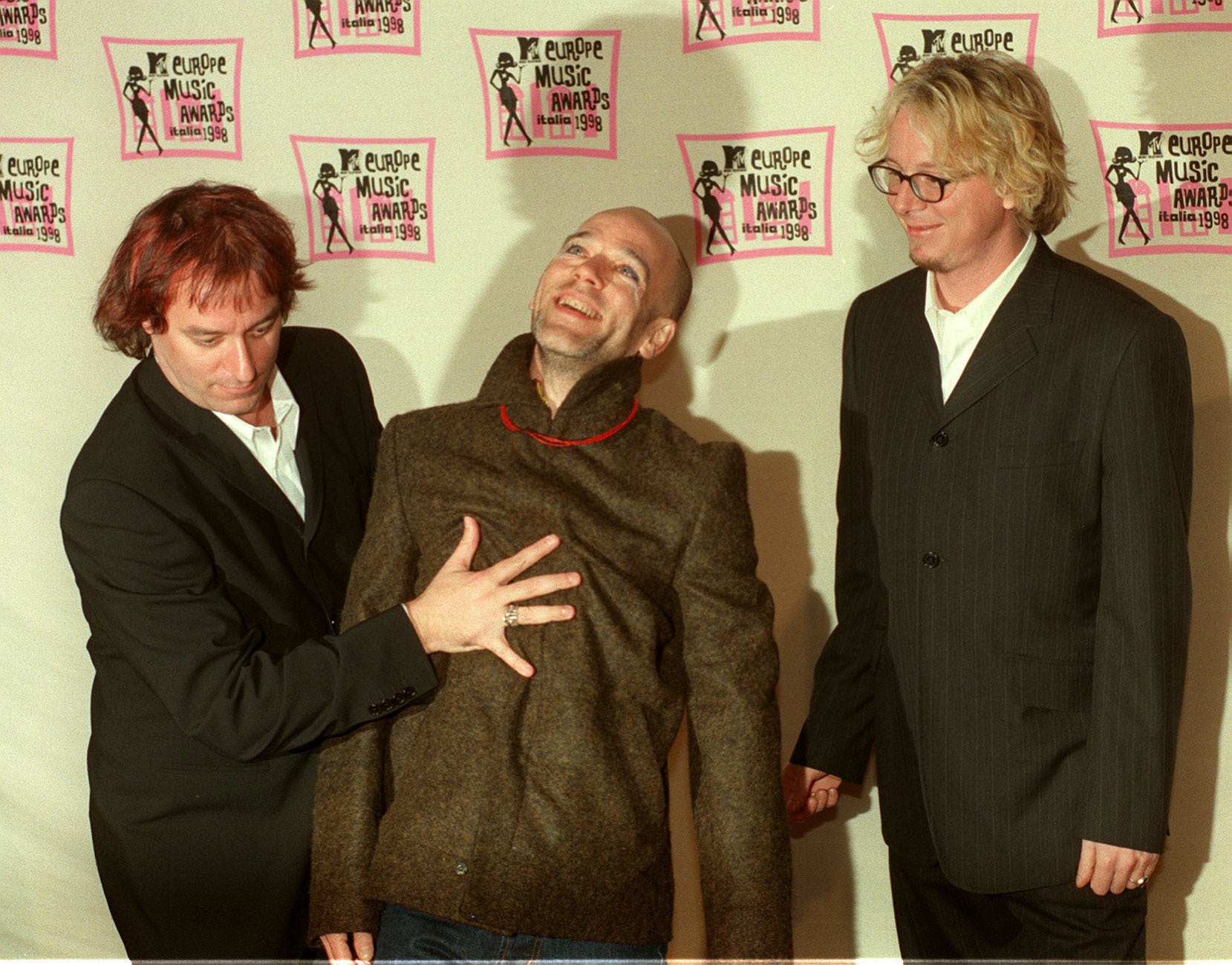Euphoric for the people: Why it’s time to rehabilitate REM’s Shiny Happy People
As REM’s 1991 anthem reaches its 30th anniversary, Ed Power looks back on one of the band’s biggest hits – and how they tried to scrub it out of their history

Your support helps us to tell the story
From reproductive rights to climate change to Big Tech, The Independent is on the ground when the story is developing. Whether it's investigating the financials of Elon Musk's pro-Trump PAC or producing our latest documentary, 'The A Word', which shines a light on the American women fighting for reproductive rights, we know how important it is to parse out the facts from the messaging.
At such a critical moment in US history, we need reporters on the ground. Your donation allows us to keep sending journalists to speak to both sides of the story.
The Independent is trusted by Americans across the entire political spectrum. And unlike many other quality news outlets, we choose not to lock Americans out of our reporting and analysis with paywalls. We believe quality journalism should be available to everyone, paid for by those who can afford it.
Your support makes all the difference.Whoop… here we go!” It’s early 1991 and, on the set of Saturday Night Live, Michael Stipe is pogoing and waving his hands like he just doesn’t care. But his huge grin indicates he cares a lot, and that he’s having the time of his life.
Spring has dawned on the 1990s, bringing with it the promise of a new era for mainstream rock. Grunge is on the horizon. And REM, jangly dodgers from the relative backwater of Athens, Georgia, are about to become among the biggest bands in the world. Right now, they’re in New York rehearsing the single that will help seal their transition from alt-pop underdogs to generational spokespeople. They are singing “Shiny Happy People” and their enthusiasm has an almost luminescent quality (though that may have also have something to do with Stipe’s extravagantly white suit).
“Shiny Happy People”, which marks the 30th anniversary of its UK release today (6 May), is a great lost 1990s anthem. One of REM’s biggest hits, it was, in the months after its reached the airwaves, simply inescapable. The band had written it as a challenge: could they replicate the wholesome silliness of 1960s power-pop acts such as The Monkees and The Banana Splits? And it became an instant phenomenon, giving the group their highest ever UK chart placing up to that point. Reaching No 6, it peaked 13 places higher than preceding 7-inch “Losing My Religion”. And it was a highlight of the accompanying album, Out of Time, which galloped to No 1 in both Britain and America.
“It’s a great song,” says Ethan Kaplan, curator of the definitive REM fansite Murmurs.com. “There’s no denying that it is immaculately written, constructed and recorded.”
“I love that song. It makes me so happy when I hear it,” agreed Kate Pierson, the B-52’s vocalist who sings on the track, in an interview with Vulture in March. “The lyrics are so uplifting and beautiful.”
Rehearsing on Saturday Night Live in April, REM appeared to appreciate they had created something special. Stipe wearing what looks like a dress jacket made from paper bounced in the manner of a cartoon character brought to life. Next to him, Pierson – an old friend from their days on the Athens indie scene – matched Stipe dance move for dance move. And when they got to the chorus and bassist Mike Mills sang “Shiny Happy People”, followed by Pierson and, finally, Stipe, it was like a triple layer-cake of indie goodness. It was fantastic. It was also one of the last times REM would ever play the song, or even acknowledge its existence.
En route to the single’s US release two months later, in July 1991, REM apparently decided they hated “Shiny Happy People”. And they scrubbed it out of their history. They rigorously avoided playing it on tour (they did, however, do a jokey version, “Furry Happy Monsters”, on Sesame Street in November 1998). And the song, their first UK top 10 smash, was conspicuously absent from their 2003 Warner Brothers greatest hits, In Time: The Best Of REM. Why did the gloss go off “Shiny Happy People” so quickly?
Many artists wind up hating their biggest hits. For years, David Gray disliked playing “Babylon”. Rory Graham, aka Rag’n’Bone Man, recently admitted to growing slightly fed up of hearing “Human” whenever he left the house. Still, few bands have run screaming away from a calling card as emphatically as REM from “Shiny Happy People”. “It was bubblegum music made for kids,” Stipe would tell Mojo in one of many interviews in which he looked back on the track with a sort of shrugging indifference. “I don’t hate it. But I don’t want to sing it.”
He may have arrived at that opinion later than some of his bandmates, at least one of whom had misgivings from the outset. “Shiny Happy People” had started as a country rock riff bassist written by Mike Mills as REM were touring their previous LP, Green (the indie stars’ major label debut). Eighteen months later, writing Out of Time in Athens, somebody – the details are lost in the murk – thought it might be a good idea to offset the zinging guitar with a waltz in the intro and mid-section. Stipe, meanwhile, set himself the challenge of penning lyrics that communicated an unabashed glee. Later, mixing Out of Time at Prince’s Paisley Park studio complex, they invited Pierson to improvise over the top. Upon hearing the finished version, Mills was reportedly “aghast”.
Enjoy unlimited access to 100 million ad-free songs and podcasts with Amazon Music
Sign up now for a 30-day free trial
Enjoy unlimited access to 100 million ad-free songs and podcasts with Amazon Music
Sign up now for a 30-day free trial
At any rate, that was his response in the moment (according to Marcus Gray’s REM biography, It Crawled From The South). Twenty-five years on, promoting an anniversary reissue of Out of Time in 2016, he had mellowed slightly. “It wasn’t quite so chirpy when we first did it, but it became chirpy, and that’s fine,” he told Rolling Stone. “The upside and downside of being in a band is that by the time the song is finished it may not be at all what you thought it would or should be.”

“We came up with the music and were all laughing about it,” added guitarist Peter Buck in the same interview. “When we recorded it, we just thought, ‘Ah, whatever.’ And then Michael came up with the lyrics and we just thought, ‘You know, whatever.’”
In 1991, some listeners struggled to take “Shiny Happy People” at face value. Was there a joke they weren’t getting? A hidden meaning? Maybe a clue was to be found in the video, which featured the David Lynch-esque touch of an old man cycling on the spot. Stipe, though, always denied “Shiny Happy People” had come from a place of cynicism: that it was a sneering, indie rock equivalent of Monty Python’s “Always Look On the Bright Side Of Life”.
What he couldn’t refute was that this serving of sonic sunshine was flecked with shadows. Stipe had taken the phrase “Shiny Happy People” from Chinese Communist Party propaganda posters which had gone up around Beijing following the brutal suppression of the 1989 protests in Tiananmen Square Square. So while the lyrics were sincerely upbeat they contained, like a sundae laced with arsenic, a reference to a humanitarian outrage.
“On the one hand, it’s this satirical, political thing. And on the other it’s like a kid’s pop song on Sesame Street,” Jon Wheeler, guitarist and mandolin player in REM covers band REMbrandt, tells me. “I’m not down on it, because I think it has levels. I don’t mind performing it, and I like that it’s a song that enables an audience connection. The band have written any number of what I would consider “better songs”. But they’re not necessarily the ones that people remember 30 years later. There’s something to be said for that.”
“The remarkable thing about ‘Shiny Happy People’ is its malleability,” say Tim Minneci and Jason Dziak, hosts of the Dig Me Out 1990s indie rock podcast, in an email. “It’s Stipe’s dig at the authoritarian propaganda of the early 1990s Chinese government. It’s also written for children with a nod to The B-52’s. It’s the polar opposite of the previous Out of Time single ‘Losing My Religion’ – as if to cut off the oncoming onslaught of angsty alt-rock fans at the pass and remind them that major keys, sunny harmonies, and unbridled joy can be just as counter-culture as metal dirges and punk venom.”

REM never entirely mellowed on the tune, as already pointed out. And they refused to let the producers of Friends use it as the theme for the series in 1994. Instead, Los Angeles duo The Rembrandts were hired to pen a ditty that sounded a bit like “Shiny Happy People”. “Then they went to another band and said, ‘Can you write an REM song?’” Stipe told the NME.
However, Stipe would later acknowledge “Shiny Happy People” as showcasing a different side to REM. “Many people’s idea of REM, and me in particular, is very serious, with me being a very serious kind of poet,” he told The Quietus in 2011. “I’m also actually quite funny – hey, my bandmates think so, my family thinks so, my boyfriend thinks so, so I must be. But that doesn’t always come through in the music. People have this idea of who I am probably because when I talk on camera, I’m working so hard to articulate my thoughts that I come across as very intense.”
But REM obsessives will have already known there was more to Stipe than the poetic melancholy of “Losing My Religion” or 1992’s stalked-by-mortality Automatic for the People. “Shiny Happy People” was obviously a spiritual successor to the ebullient “Stand”, one of the big hits from Green. And melodically, it was essentially a sped-up version of their 1986 single “Fall On Me”. And it can be regarded as forerunner to 2001’s “Imitation of Life”, one of their last great singles.
“There was and is something amazing about how REM could grab a hook and run it all the way home,” says Ethan Kaplan. “This wasn’t new. If you listened to any of the early stuff, the pop hooks were there. And certainly the pre-Chronic Town [the group’s 1982 debut EP] prototype REM stuff was very pop.”
“Shiny Happy People” maybe makes more sense today than all those decades ago. Maybe it was an anthem out of time. In 1991, when the cult of the tortured rock star was at its height and it was widely felt that suffering made for the best art, it may have struck rock fans as cheesy and frivolous. And it is true that the cloying waltz breakdown wears its welcome out pretty quickly.
Yet the chorus – Mills’s voice, followed by Pierson’s, followed by Stipe’s – is soaring and hugely moving. REM decided they were too cool for “Shiny Happy People” first time around. Thirty years later, perhaps they, and us, can finally enjoy it for what it is: three minutes and 45 seconds of pure, escapist joy.



Join our commenting forum
Join thought-provoking conversations, follow other Independent readers and see their replies
0Comments